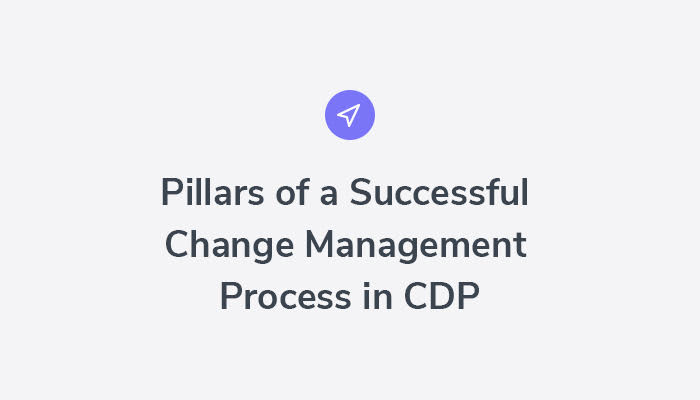Five Pillars of a Successful Changement Management Process for CDP Initiatives

To become customer-centric, businesses are doubling down on their investments in smart hubs such as customer data platforms (CDPs). These technologies enable brands to centralize and scale personalization—a competitive imperative in the digital age.
However, technology alone will not never get you there. Customer centricity also requires a robust, strategic approach to organizational change management based on proven best practices—and the agility to support continuous improvement of the customer experience.
“Companies must move beyond the initial excitement of ‘one-to-one marketing’ and into the low-thrill but crucially important realm of organizational change,” write McKinsey analysts.
At the level of people and processes, many marketing organizations still operate in channel-specific and/or journey-specific silos. “We find marketing organizations still operate in a bit of a legacy process,” McKinsey’s Jason Heller told audiences at the 2019 DynamIQ conference.
With the right CDP, you can unify, analyze and activate all your customer data, both historic and real time, across all your channels. However, that is only a first step toward customer centricity. You also need a new management model that encompasses a wide swath of your marketing team members as well as your current business processes.
Fortunately, that transformation does not have to have to happen all at once. You can engage in a step by step process in which you identify, prioritize and execute specific use cases one-by-one.
Still, to implement successfully, a change management process is not easy. In fact, a recent McKinsey study found that almost 50% of all digital transformation initiatives do not achieve their expected value—and only one in 10 manage to exceed expectations. And another industry survey found that a lack of skilled staff and training were two of the top reasons that the ROI of marketing technology investments fell short of expectations.
“Driving change is all about working with people. It’s setting a vision about where you want to head, and where you are today, and then being able to alleviate these fears,” says Mike Amend, president of mega-retailer Lowe’s online business.
Every business will have its own unique goals for a CDP, and will need to forge its own management processes, business processes, and project team to achieve them. The good news is, in our work helping brands to become customer-centric, we have established a proven framework for organizational change. And the effectiveness of our change model is borne out by two KPIs—our near-perfect customer retention rate, and our 100% referenceable customer base.
Our approach to effective change management consists of five pillars that help you avoid negative impact and ensure continuous improvements across your marketing operations:
- Align on the “why,” not the “how”
- Map critical tasks
- Assess organizational maturity and develop a phased, step by step approach
- Identify risks and manage resistance
- Engage in a value mapping process
#1 Align on the “why” of CDPs, not the “how”
Many organizations make the mistake of building a change management plan based on specific capabilities of the CDP solutions they are considering. As a result, they tend to choose solutions that claim to have the most bells and whistles, which can actually lead to the selection of a less than ideal option for their particular business needs and goals—and, of course, to less than effective change management.
In our experience, you are much more likely to meet or exceed expectations if you flip that paradigm upside down. That is, instead of concentrating on what a CDP may be able to do, ask yourself first why your organization needs a CDP in the first place. Questions to ask include:
- Why do I need a solution that can unify all my relevant customer data (both historical and real time)?
- Why do I want to use that data to gain granular, predictive insights about individual customers?
- Why is it important for me to orchestrate experiences quickly, even automatically, across all channels?
In this way, you concentrate on what you want to accomplish, rather than what a particular solution might be able to do for you.
To break the process down further, here are four key steps to answering the question “why”:
- Create a strong business case for change initiativeTo manage resistance and overcome it, you must be able to show that the inevitable pain of change will help deliver overwhelming value. This is the only way to get stakeholder buy-in, especially from the executive suite. As you take your first steps toward your CDP initiative, create a convincing business case, including quantifiable return on investment (ROI). Your business must be strong enough that you can use it to reach across all key constituents that may resist change, from the C-suite to marketers on the front line.
- Set a clear, overarching vision for the brandEven when you can demonstrate the value of a CDP to your organization, you must establish a clear, overarching reason that goes beyond simply ROI. Ultimately, it should come down to a vision of how customers will perceive your brand.Here is just one example. One of our clients said their vision was to reassure customers that, before they had to reach out to the brand with an issue, the brand would reach out to them first. Whatever your vision, make it the clear, simple North Star that will align all your people, processes, and technology as you head toward a common destination.
- Build out a “step process” roadmapA brand-wide vision can only become a reality when you have a long-term roadmap for getting there. However, this roadmap must also include short-term and medium-term goals. This way, you build in quick wins and the ability to demonstrate progress—vital to to win over stakeholders, as well as to build energy and momentum for the long haul.According to one McKinsey study, successful change management plans should begin with a sense of urgency out of the gates. Once you achieve small wins, you can then channel that early burst of energy into a more rigorous strategic management plan over the long term. Companies that do so achieve capture 28% of their fully ramped-up value within three months, according to McKinsey, and 74% within the first year.
- Define metrics for successYou can only win credibility if you’re willing to define the specific success factors of the change management process. That means establishing key performance metrics—and a management model for communicating success.Ultimately you will no doubt create a variety of different KPIs. However, it is also essential to establish one overarching metric. And this should be the metric that lets you and the wider team know that your organization is staying on course toward your overarching vision. Depending on your business, this KPI could be retention rate, NPS score, or revenue per customer. Once you identify the best overarching KPI, link it to function-specific KPIs for different marketing activities, like frequency of visits to the store, email engagement, time on site, etc. In this way, you give all your team members a stake in contributing to your success.
#2 Map critical tasks before skills and roles
As we mentioned, a dearth of skilled staff is one of the main factors that leads to lower-than-expected ROI from martech investments. However, this does not mean that, in the desire to avoid this at your organization, you should rush to define new roles and search for the right talent to fill them. In our experience, this is an organization-centric management model misapplied to a customer-centric strategy.
Instead, we suggest taking a step back, and that you begin by defining not the roles you need to fill, but the tasks that will be required, and then the specific skills required to support those tasks. In general, the tasks required to implement and operationalize a CDP can be roughly divided into four functional areas:
- Data Access
- Strategy & Insights
- Planning & Operations
- Data Science
As an example, let’s look at just one of these functional areas—data access—and break it down by critical tasks and skills required, rather than roles you need to hire for:
- Critical tasks
- Support data and channel integration setup
- Translate data to business definitions
- Troubleshoot data pipeline issues
- Required skills
- Knowledge of internal data sources
- System-specific IT expertise
- Effort timeline
- Very significant during implementation
- Occasional post-implementation tasks
#3 Assess your organizational maturity and develop a phased, step by step approach
Once you have mapped the tasks and capabilities you need, it is time to create a new map of your entire organizational structure as you move toward adopting a customer-centric management model.
It may be tempting at first to take an all-or-nothing approach to organizational change. For example, you may want to embark on a radical group-wide reorg. On the other hand, you look for ways to jam the entire customer-centric operating model onto your existing organizational structure.
However, there is a third way—a measured, phased approach that, in our experience, has consistently worked best for our clients. This approach focuses you first on the early phases of your initiative, so that you can gain some quick wins to build momentum for your larger change management model. Great places to get quick wins include operationational efficiency and productivity gains.
But before you get started, first assess how mature your organization is today in terms of customer-centricity. While every business is different, there are three basic levels of marketing maturity:
- Channel-centric. While channel-centric organizations can achieve a certain degree of basic customer centricity, personalization still tends to be siloed by channel, with true omni-channel personalization only on an ad hoc basis and requiring significant resources each time. At channel-centric organizations, both teams and technologies are distributed by channel, and metrics for success tend to be limited by channels, too—for example, open rates and click rates.
- Journey-centric. These organizations can create connected experiences across all channels, but only within a single stage of the customer lifecycle, for example customer on-boarding. At these organizations, teams tend to be distributed by journey, even if supporting technology is centralized and consolidated. KPIs at journey-centric organizations include CAC and engagement.
- Customer-centric. These organizations are able to deliver personalized, contextual experiences to individual customers across all channels and all lifecycle stages. At these organizations, both teams and technologies are centralized and shared across the full customer experience. KPIs encompass the entire customer lifecycle as well, for example LTV and retention.
Ultimately, your goal is to move toward a customer-centric org structure, of course. In this way, a single team member can work with much greater efficiency and productivity, since they can scale their skills across multiple functions. And there is the added benefit that you can cross-train team members, which supports the kind of agility that true personalization at scale demands.
#4 Identify risks and manage resistance
Organizational change management always entails risks and generates at least some degree of resistance when implementing change. And since CDP fundamentally changes how your organization operates, it can be scary for people at all levels of your organization. One way to reduce fears around job security is actually to make clear to team members what will not change. In other words, to create what is sometimes called a “stability plan.”
It is also critical to appoint a dedicated project manager, who will serve as a single point of contact for the entire breadth of your CDP initiative. The project manager ensures that all parts of the project are moving and tracks progress to your timetable and the other success metrics you have established. The project manager should also be responsible for reporting on progress, not just to the project’s executive sponsors but to all parties involved.
With that in mind, here are a list of the most common risks and roadblocks, along with strategies to mitigate them:
- A weak data foundation. Be clear about which use cases are your highest priority, and identify critical data sets to meet them, and then concentrate your resources on solving for these first.
- Disruption of current business processes. Holistically audit and optimize all processes that impact customer use cases, and do not limit yourself to re-engineering current processes only.
- Lack of skilled staff. Avoid the common mistake of underestimating the support you will need, and consider budgeting support from partners, so you can vet talent prior to hiring.
- Lack of training. Make support and services a priority when evaluating and selecting a CDP vendor—and request references from existing clients whose organizations are similar to yours.
- Resistance to change. For many reasons, you should ensure that your project has the full backing of your CEO. And make sure that exec support is clearly visible across the organization—and that teams are incented accordingly.
- Lack of accountability. In addition to a project manager, adopt a governance structure that includes an executive sponsor and cross-functional steering committee, with regular updates from working teams.
- Lack of organizational alignment. Create a cross-functional governance team, and establish incentive structures for all stakeholders in a way that supports your new customer-centric operating model.
#5 Engage in a value-mapping process for effective change
When you are ready to take your first concrete step toward implementing a CDP, we can provide a two-week, expert-led value-mapping service that helps you define critical factors for success for your unique organization. During those two weeks, we will help you:
- Establish best practices. Identify the strategic vision for your initiative, potential quick wins, and the people, processes and technologies that will enable you to succeed.
- Develop your business case. Document the ROI you can expect from your CDP initiative, and create a high-level roadmap that spans both implementation and how you will use the solution on an ongoing basis over the long term.
- Mitigate risk. Leverage requirements-gathering and evaluation management tools to help you prioritize requirements, vet vendors, and align internal stakeholders.
As you move your organization toward becoming 100%-aligned to the entire customer experience, these five pillars will enable pivot with agility as you move from one milestone to next.
Most importantly it will help you identify your “North Star”—and use it to orient your entire team through the challenging but also exciting process of organizational change management.





